Deep fat fryer purchasing advice: how to choose the right product
- What You Need to Know
- There are many different types of deep fryers. In addition to the usual electric fryer, there are cold-zone fryers, hot-air fryers, roto-fryers, spin fryers and gas-heated fryers.
- Deep fryers are becoming more and more versatile. Hot air fryers in particular, which offer low-fat preparation methods and the possibility of preparing other foods, are enjoying great popularity.
- When buying a deep fryer, in addition to deciding on a type of fryer, there are some important features and characteristics to look for. However, a temperature controller, a temperature limiter, a timer function and a dishwasher-safe deep fryer pot should be available in any case.
- When using a deep-fat fryer, there are a few aspects to consider regarding the use and cleaning of the appliance for the sake of your own safety and health.
Super hot: deep fryers
Although the per capita consumption of potatoes and potato products has been constantly decreasing for years and the average German consumes only about 56 kilograms of the golden tuber annually, potato products have been among the most popular deep-frozen products for decades, with sales of over 400,000 tonnes annually.
One form of preparation continues to enjoy great popularity: French fries. Although it is also possible to prepare frozen fries in the oven at home, the golden-yellow potato strips only get the right “bite” and authentic taste in a deep fryer.
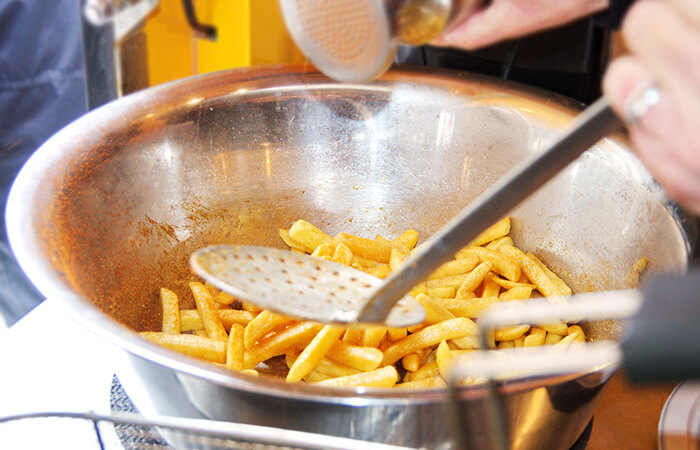
Since deep-fat fryers are not only becoming cheaper, more convenient and easier to use, but also offer increasingly low-fat and fat-free preparation options, it is hardly surprising that they are enjoying ever-increasing popularity in private households.
French fries
The term originates from French, as this specific form of potato preparation originally comes from Belgium. It stands for “Pommes des terre frites”, which means “baked potatoes”. French fries were probably already being prepared in Belgium before 1680.
The range of dishes that the user can prepare with a deep fryer is by no means limited to the popular potato strips. In addition to other potato products such as croquettes, potato pancakes or wedges, popular deep-fryer dishes include meat, fish and various vegetables such as cauliflower, courgettes or mushrooms. Even cheese, bananas, strawberries or apple rings can be fried in the deep fryer.
Would you like something sweet afterwards? Popular desserts from the deep fryer include donuts, quark balls or doughnuts. An interesting trend comes from England, which is known for its unusual eating habits: here, chocolate bars are deep-fried. In the following video, YouTuber dimxoo shows how to do this in a tutorial:
How does a deep fryer work?
Deep-frying in the true sense of the word refers to a cooking process in which food with a water content is completely immersed in cooking oil or fat heated to temperatures between 140 and 180 degrees Celsius in a deep-frying basket. This causes the starch to gelatinise and the protein components to denature, i.e. break down. This makes the fried food more digestible and tastier for the consumer. The bath in the hot fat ensures that the moisture on the surface of the food decreases, a crust forms and flavourings are created.
In the process, different foods absorb a different amount of fat, depending on the size of their surface. Here are some examples:
| Frying medium | Fat absorption |
|---|---|
| Crisps | Absorb between 30 and 40 per cent of their mass in fat |
| Doughnuts/berliners | Absorb between 15 and 20 per cent of their mass in fat |
| French fries | Absorb between six and twelve percent of their mass in fat |
The added value of a deep fryer compared to frying food in an oil-filled pot is obvious:
- Temperature can be set, controlled and regulated
- Fat is in a closed pot and cannot splatter
- Food drips off warm after frying and thus absorbs less fat
Different types of deep fryers
Deep fryers are defined as kitchen appliances used to fry food in hot oil or fat, the deep fryer. There are electric deep fryers, gas-fired deep fryers and hot air fryers. The latter are not deep fryers in the strict sense of the word, as they do not use a deep fryer, but only hot air to complete the cooking process. In common usage, however, they are still considered deep fryers, as they can be used to prepare the same foods as in a conventional deep fryer, and because they do not require no fat at all.
Cold zone deep fryer
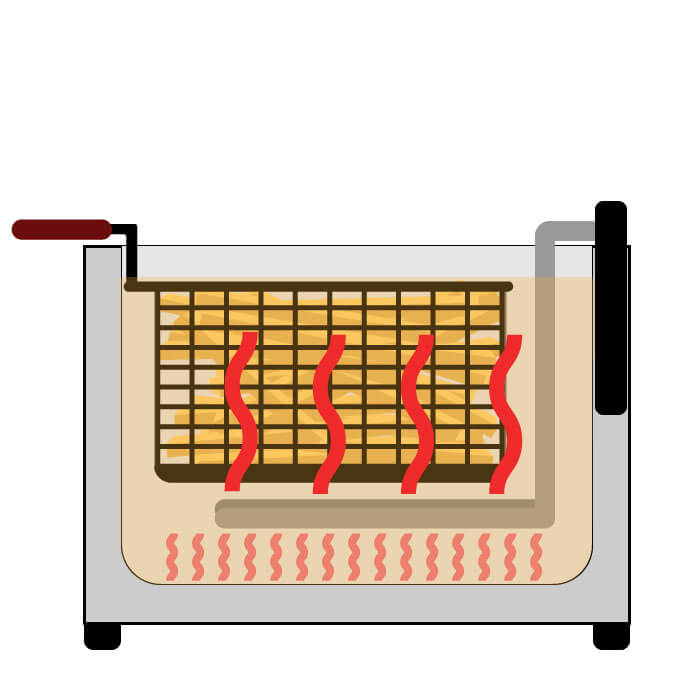
The majority of today’s deep fryers, which use oil or fat as a heat transfer medium, have a so-called cold zone. This ensures that the fat at the bottom of the frying container becomes less hot, which reduces the formation of acrylamide. With this type of deep fryer, the electric heating element is therefore not located in the base plate, as is the case with conventional electric deep fryers, but hangs directly in the oil in the form of a kind of immersion heater.
This technology offers some advantages and disadvantages compared to the conventional electric deep fryer. The bottom of the frying container remains comparatively cool, the fat temperatures are only 50 to 70 degrees Celsius. In this “cold zone”, residues of the breading or suspended matter do not burn, which results in less acrylamide. The oil can be used longer because of the non-burning residues and the taste is not negatively affected. A conventional electric deep fryer offers no advantages of this kind. However, it is easier to clean because the frying container is completely removable and its interior does not come into contact with the heating element.
Here we offer a brief comparison of the advantages and disadvantages of cold-zone deep fryers:
Pro Points
- Less acrylamide formation
- Oil can be used for longer
- Lower power consumption
- Better taste
Drawbacks
- Heating element in direct contact with oil
- Heating element always needs cleaning
Spin and Roto fryers
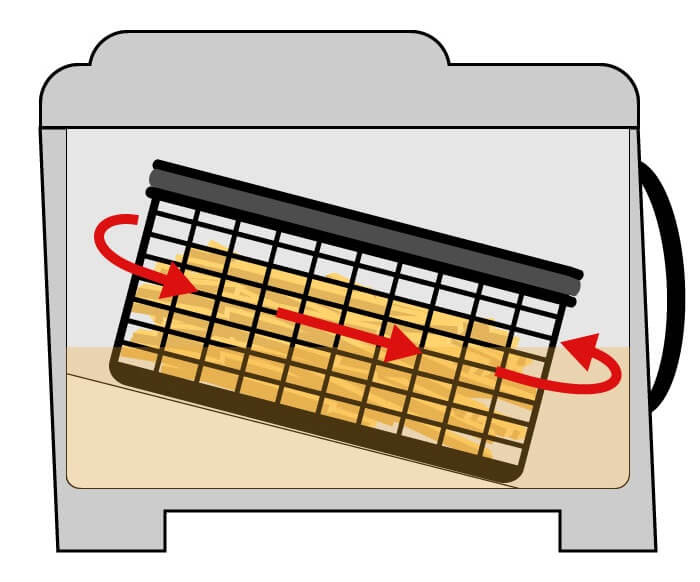
Spin fryers are a special type of fryer. They also operate on the principle of frying food in oil or fat at high temperatures. In contrast to the conventional deep fryer or the cold zone deep fryer, however, spin fryers prepare the food with less fat. After frying, these models remove excess fat from the food by spinning it around quickly, like a salad spinner. The round frying basket rotates on its own axis and makes use of the centripetal force.
Roto-fryers achieve a lower fat content by repeatedly immersing the food to be fried in the rotating frying basket in the hot fat for only short periods of time. In contrast to the spin fryer, the basket is not suspended horizontally but at a slight angle.
Pro Points
- Deep-frying food strongly reduced in fat
- Typical deep-frying aroma is retained
- About 50 percent less oil needed
Drawbacks
- Less suitable for large dishes
- Less capacity or larger appliance required
One disadvantage of these low-fat preparation methods is that they are not equally suitable for all foods. However, unlike hot-air fryers, they offer the typical deep-frying aroma.
Gas fryers
Gas-fired deep fryers are used less in the home and more in the commercial sector. They are larger and more expensive. However, gas firing via tube and rod burners pays for itself relatively quickly due to the low operating costs compared to electrically operated appliances. All deep fryers for private use are usually electric models.
Hot air fryer
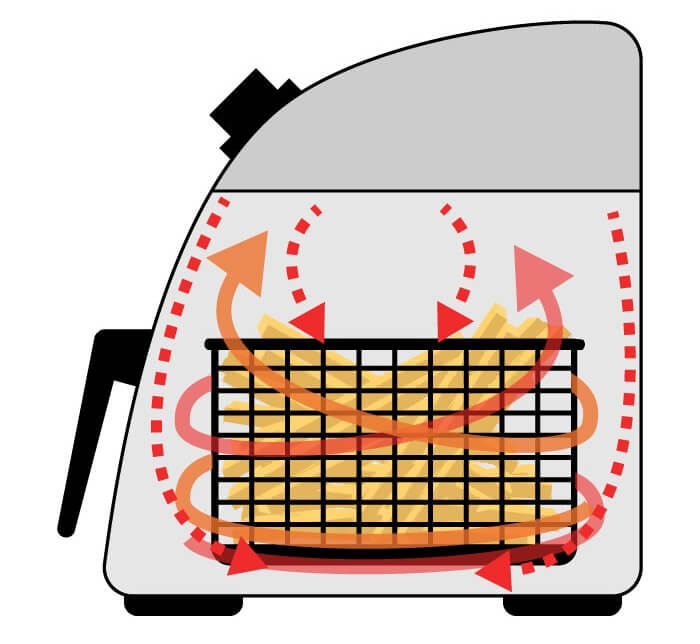
Hot-air fryers are currently very popular with amateur chefs. This is hardly surprising, as they offer a number of advantages over conventional deep fryers. Particularly in view of the increasingly popular low-fat diet, the possibility of deep-frying low-fat food is tempting. Trans fats, which are produced by heating processed oils and fats, are largely eliminated here. Acrylamide formation is also said to be significantly reduced in hot-air fryers.
Hot air fryers require very little oil. In most models, only 10 millilitres of fat need to be added. This is due to the way these appliances work: they do not deep-fry the food in fat, but cook it with a rotating stream of hot air. This process offers some significant advantages, but disadvantages are not entirely absent:
Pro Points
- Low-fat and low-calorie preparation
- Safer, as no oil can spill or spike
- Minimal odour formation
- Other foods can also be prepared
- Little cleaning required
- Saves follow-up costs as hardly any oil is needed
- Energy-saving
Drawbacks
- Higher initial costs
- Longer preparation time
- Sticking together of food parts if no stirring function available
- No typical deep-frying taste
- Acrylamide is still formed
Hot-air fryers are more expensive than their conventional relatives and take much longer to prepare food. Preparation times of 15 to 30 minutes are the rule rather than the exception. On the other hand, they are much safer and easier to clean because of the absence of hot fat. In addition, they are more versatile because they do not fry in the conventional sense and the user can also use them to prepare dishes such as goulash, bread, pizza or cakes.
However, the user should also avoid preparation temperatures of over 180 degrees Celsius if he wants to avoid the formation of acrylamide in high quantities. The fat content in the prepared food is indeed significantly lower than in conventional deep fryers. In this respect, the hot air fryer is the healthier alternative.
What should I look for when buying a deep fryer?
Every deep fryer should be made of stainless steel and easy to clean. A secure stand and rubberised feet are important so that the deep fryer does not easily tip over and cause severe contamination or even serious injury. For other aspects, the relevant criteria depend on the type and functionality of the fryer in question.
What is important about deep fryers that use hot fat for deep frying?
Every deep fryer that deep-frys food in fat, i.e. conventional electric deep fryers, cold-zone deep fryers, roto-fryers and spin fryers, should provide an outlet opening through which the user can safely drain the fat. For safety reasons, this should not be too easily accessible or too smooth-running. Likewise, the heating device should have a safety device to prevent burns. A temperature regulator, an automatic temperature limiter and a timer function are also a matter of course to prevent the frying door from overheating and charring the fried food. It is considerably easier to clean the deep fryer properly if the frying pot is completely removable and dishwasher-safe.
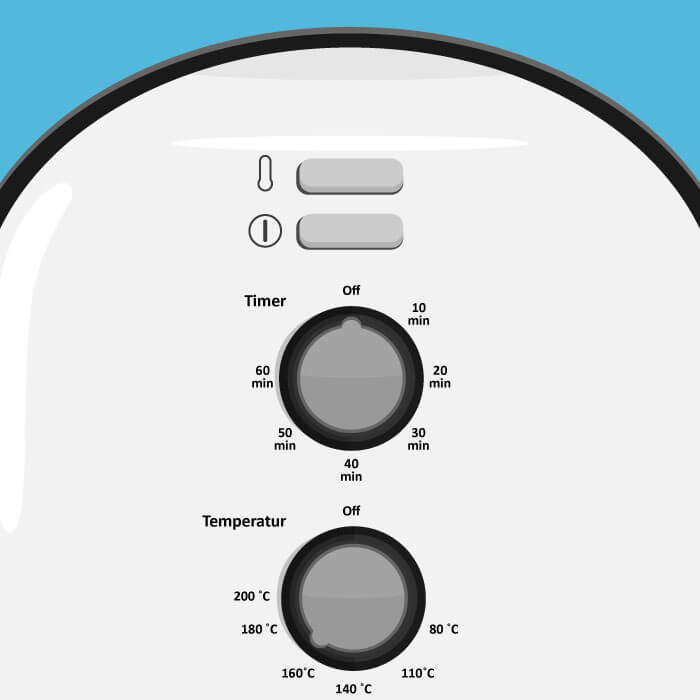
However, cold-zone deep fryers hardly have any extras, special functions or accessories. For ease of use, the user should choose a model that has a display.
For home use, it can also be advantageous if the deep fryer has several frying basins and baskets. This is because the user should also use different deep fryers for different types of food in order not to negatively influence the taste of the food.
Prospective customers should also pay attention to sufficient power. The more watts a device has, the faster the frying fat reaches the desired working temperature. However, if the wattage is too high, there is a risk that the fat will become too hot, thus promoting the formation of acrylamide. Appliances between 1,400 and 1,800 watts are recommended and are now considered the norm.
Here is a summary of the checklist:
- Outlet opening for grease change
- Safe and separate heating device
- Temperature controller
- Temperature limiter
- Timer function
- Dishwasher-safe frying pot
- Display
- If necessary, several frying baskets
What is important with hot air fryers?
If you decide to buy a hot air fryer, you should always make sure that the appliance has an automatic stirring function. This ensures that the food is mixed and turned regularly. Since the food is not in an oil bath, this is necessary because otherwise the heat would not reach all parts and the food would not be fully cooked and stick together.
A hot-air appliance should have a viewing window. This allows the user to see how far the cooking process has progressed during operation without having to interrupt the process and open the appliance.
A temperature control with display and a timer function are standard features. A drip tray is necessary to catch any excess fat that escapes from the food during the cooking process. Since the hot air fryer offers the user not only conventional deep-frying but also other preparation methods, additional inserts, for example for grilled food, are recommended. The scope of delivery should also include a measuring cup or measuring spoon. This allows the user to precisely measure out small amounts of fat to be added.
Here are the most important criteria in the form of a checklist:
- Automatic stirring function
- Viewing window
- Removable compartment for deep-frying food
- Temperature control
- Temperature limiter
- Timer function
- Dishwasher-safe compartment for deep-frying food
- Display
- Drip tray for excess fat
- Separate grill insert
- If necessary, several frying baskets
What should I look out for when using a deep fryer?
There are a number of aspects to consider, not only when buying but also when using the newly purchased deep fryer, in order to operate the deep fryer as safely as possible on the one hand and to be able to enjoy the appliance for a long time on the other.
Safety and health first
Hot oil or fat can, of course, pose a real danger and cause serious burns and injuries. Therefore, the user should make sure that the deep fryer always has a firm footing on a level surface. A deep fryer should also have an integrated protective device against splashing fat, be it a lid or a bonnet. But splash protection should also remain available after the deep-frying basket has been lifted. This is not the case with all appliances. Special care should therefore be taken when lowering and lifting the deep-frying basket.
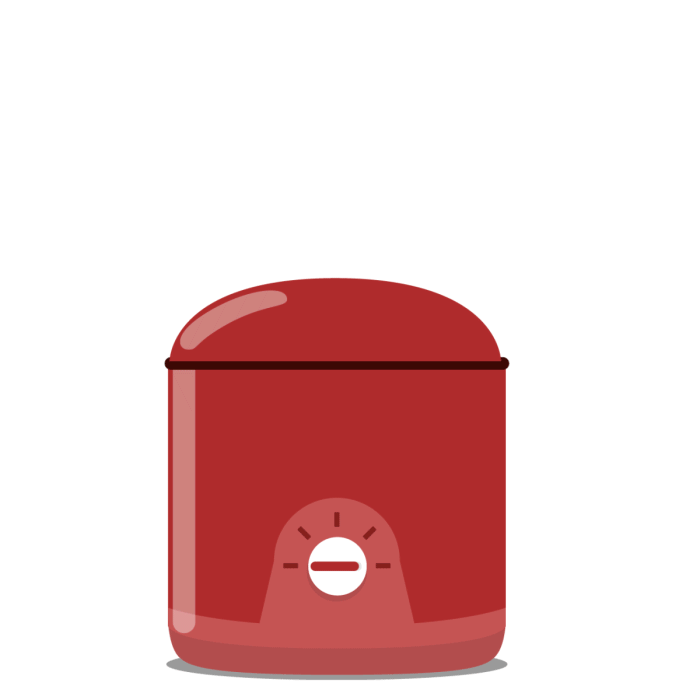
However, improper handling does not only result in direct safety risks. Health hazards caused by feeding incorrectly prepared food must also be completely ruled out. To prevent excessive splashing of the fat and any health risks, the following precautions are recommended:
PREHEAT FAT
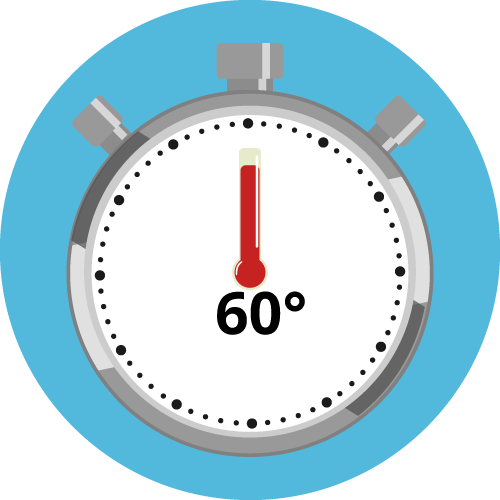
After adding solid fat, the user should first preheat it for a few minutes at a maximum of 60 degrees Celsius to melt it. Only then does he set the operating temperature. This prevents the phenomena of the fat being heated too much in some cases, resulting in splashes, and, secondly, the formation of harmful oxidative substances in the process.
KEEP THE LID CLOSED
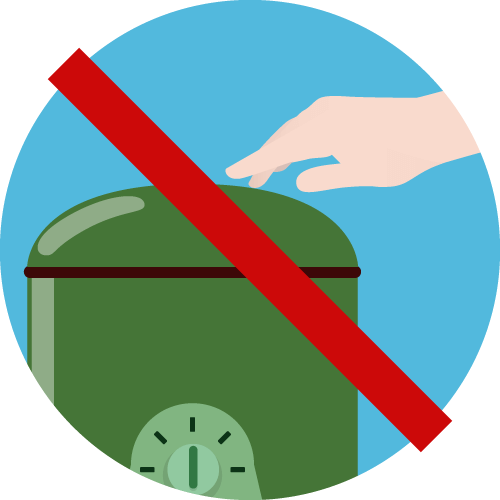
It is essential to keep the lid of the deep fryer closed during the frying process. If you lift the lid during the process, you run the risk of suddenly escaping splashes of fat and accumulated heat burning your fingers.
REMOVING CONDENSATION WATER
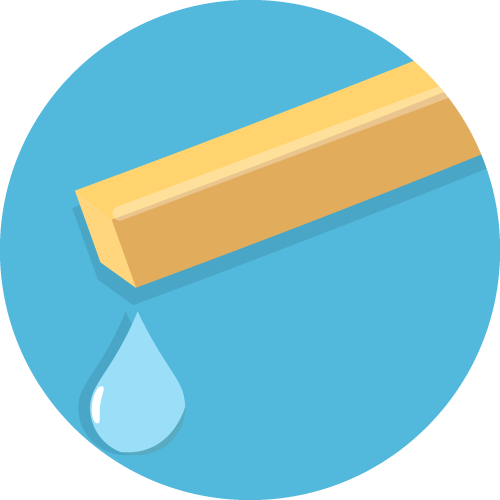
Wet food must be dried off before it is placed in the hot fat, frozen food must be slightly thawed and then dried off as well. If the surface moisture is too high, the fat may splash more.
DO NOT SALT FRIED FOOD IN ADVANCE
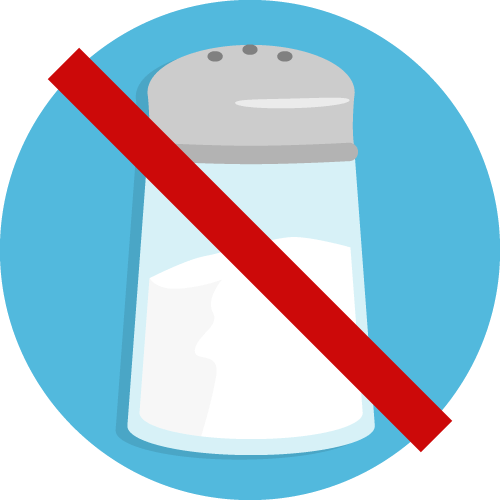
Under no circumstances should the user salt food before placing it in the deep fryer. This is because adding salt would cause water to migrate from the food to its surface, leading not only to splashing fat but to the formation of toxic substances.
SHAKE OFF CRUMBS
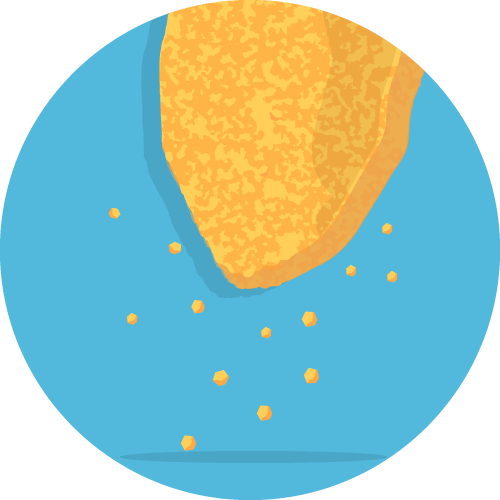
Excess breading or other crumbs should definitely be removed by the user before placing the food in the deep fryer. These small components of starchy components carbonise quickly in the hot fat, form harmful substances and promote faster spoilage of the deep-frying fat.
OBSERVE FRYING TIMES
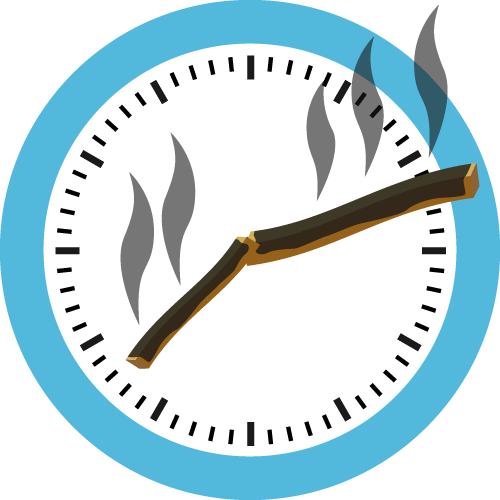
If the fried food is left in the hot fat for too long, excessive browning and absorption of excessive amounts of fat by the fried food will occur. This produces large amounts of acrylamide and other substances such as nitrosamines and sodium nitrite, which are harmful to health.
MAINTAINING FRYING TEMPERATURES
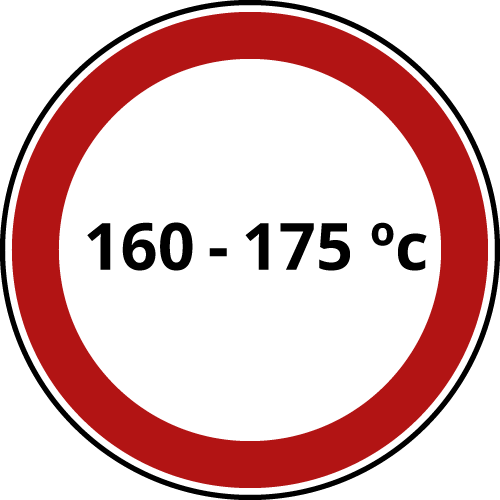
The frying temperature should be constantly in a range between 160 and 175 degrees Celsius and under no circumstances exceed the 180 degree mark. Higher temperatures lead to fat spoilage and increased acrylamide formation. Lower temperatures lead to fat spoilage
The acrylamide question
Acrylamide is formed when starchy foods such as potatoes are heated vigorously. Swedish researchers proved this in 2000. The necessary temperature is generated during baking, frying, grilling, roasting and deep-frying. Especially when potatoes and cereal products are heated dry, acrylamide begins to form at 120 degrees. The amount formed in food increases rapidly at 170 to 180 degrees Celsius.
Acrylamide attacks human DNA and is converted in the liver into glycidamide, which is also mutagenic, i.e. carcinogenic. However, it is highly controversial whether acrylamide ingested through food can cause negative effects on the human organism; a study from 2003 even refuted this connection.
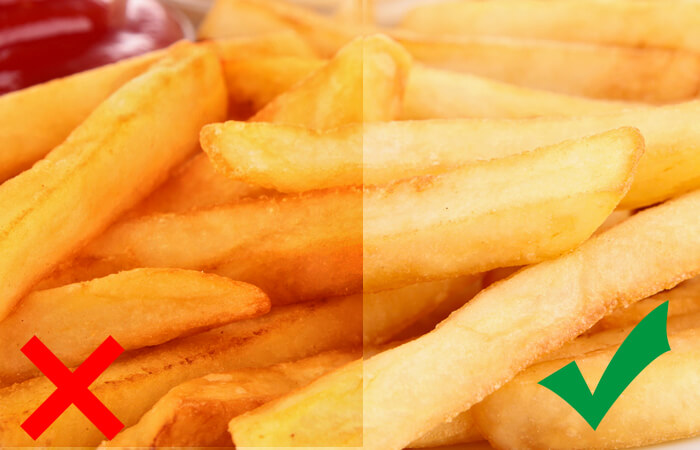
Acrylamide…
… belongs to the chemical group of amides and is mainly formed from the amino acid asparagine as a starting material in combination with sugars such as glucose and fructose. Asparagine is mainly found in potatoes and cereals.
It should be noted: A diet completely free of acrylamide is not possible and an intake in small quantities is probably not harmful to human health. Due to the lack of in-depth knowledge on the health effects on the human organism, no limit value for acrylamide in food has been defined so far – contrary to widespread opinion. The Federal Office of Consumer Protection and Food Safety only defines so-called signal values.
Those who nevertheless fear possible negative effects on their health should follow these tips: In order to keep the formation of acrylamide as low as possible, it is recommended not to store potatoes below four degrees Celsius, as at lower temperatures they form more fructose and thus one of the “ingredients” for acrylamide. In addition, changing the way potatoes are prepared can reduce the acrylamide content. For example, reducing the frying and baking temperature by only ten to twenty degrees Celsius can already significantly inhibit the formation of acrylamide. For deep-fat fryers there is an all-clear: thanks to the nowadays widespread cold-zone technology, manufacturers ensure that deep-frying is as low in acrylamide as possible.
Regular cleaning
Regular cleaning of a deep-fat fryer is absolutely essential to meet demands on the taste of the food and general kitchen hygiene, and ultimately to ensure that the appliance will function for a long time. Regular cleaning is relatively easy, especially with hot-air fryers. Those parts that come into direct contact with food or oil are completely removable and usually dishwasher-safe. Due to the small amount of oil, there is nothing special to consider in this regard.
On the other hand, anyone who owns a cold-zone deep fryer should pay attention to a few basic aspects. The user should change the oil in the deep fryer completely after five uses at the latest. For this purpose, the deep fryer should have a drain hose, a drain tap or a drain opening through which the user can drain the oil into a collection container. If the fat has hardened in the meantime, the user should first liquefy it again at 60 degrees Celsius before draining it. The emptied deep-frying pot is ideally dishwasher-safe and easy to clean in this way.
Cold zone deep fryers, where the heating element comes into direct contact with fat, require additional cleaning of this heating element. This should of course be allowed to cool down and cleaned by hand. In general, all cleaned parts should be completely dry before the next use. In detail, it is important to follow the instructions in the user manual of the respective deep fryer model.
Frequently asked questions about deep fryers
The most frequent questions from prospective customers about deep fryers mainly relate to their correct use and the deep-frying process. We address these questions.
Which fat should I use for deep-frying?
Animal fats, no matter what kind, are not suitable for frying food and for use in a deep fryer. Also unsuitable are highly unsaturated vegetable oils such as sunflower oil, virgin olive oil or corn oil. These oils spoil quickly and cannot withstand the high temperatures in a deep fryer.
In contrast, pure vegetable fats and vegetable oils with a low proportion of polyunsaturated fatty acids are suitable, for example
- Peanut fat
- Coconut fat
- Refined olive oil
- Peanut oil
Oils are excellent for short frying in private home use. In the case of using fat, it is generally advisable to purchase special frying fat.
How much fat do I need?
The amount of fat the user should use in the deep fryer depends on the capacity of the deep fryer and the amount of food to be deep fried. As a rule, there are two marks inside the deep fryer between which the level of fat should be placed in order to ensure optimal functioning of the deep fryer. If too much fat is used, the fryer will splash or leak; if too little is used, the food will not cook completely. Depending on the food to be deep-fried, the amount of fat should be selected so that the food to be deep-fried is just completely covered by the fat and reaches just below the surface.
When should I change the deep-fryer fat?
Although the cold zone deep fat fryers that are regularly used nowadays considerably extend the service life of the deep fat fryer grease, the user must of course still replace it regularly. This is because every time the deep fryer is used, components of the food come off and are gradually deposited on the bottom of the appliance. This not only darkens the fat and develops an unpleasant odour, but also affects the taste of the fried food. The user should therefore change the fat if
- the fat has a brown colour,
- smoke develops during deep-frying,
- the fat smells unpleasant,
- the fried food tastes bitter or bad, or
- the fat draws threads and is viscous when it drips off.
In general, it is recommended to change the fat after five uses or after twenty hours of operation. The user should always change the entire grease or oil and not just add new grease to the old to replenish it. The service life of the fat can be extended by the user removing ice, other traces of freezing and impurities from the food to be fried before placing it in the fryer.
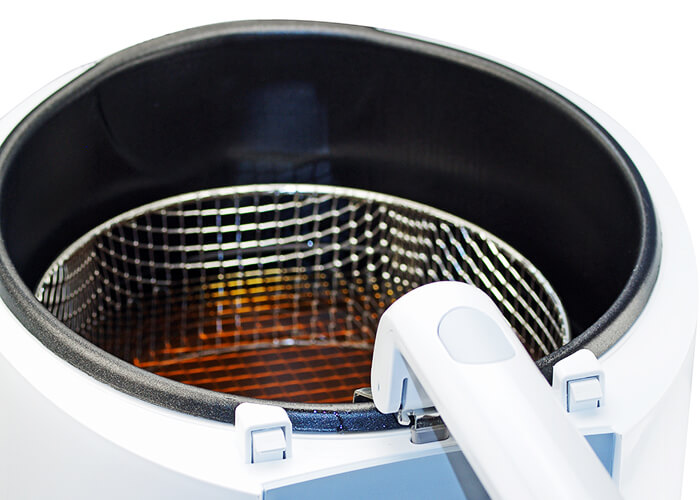
How do I know when the deep fryer is hot?
For deep-frying, the deep-fryer fat should have a temperature of 165 to 175 degrees Celsius. Modern deep fryers usually have a temperature display that makes it easy to read the current temperature, as well as a thermostat that allows the temperature to be set precisely.
Since the food to be fried has a lower temperature than the fat, the temperature of the fat inevitably cools down when the frying basket is lowered. Therefore, the user should be careful not to put too much food into the deep fryer at once, but rather fry in portions. To prevent the formation of acrylamide and to ensure that the food is cooked evenly and completely, the user should keep the fat temperature between 170 and 180 degrees Celsius after inserting the frying basket. Under no circumstances should the temperature exceed the 180 degree mark.

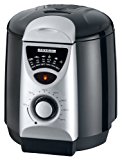
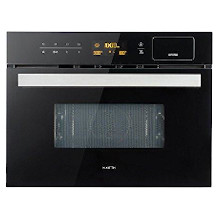
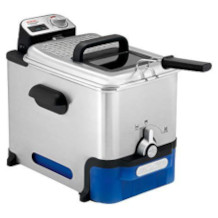
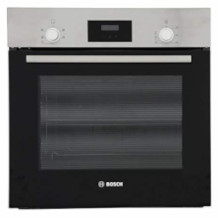
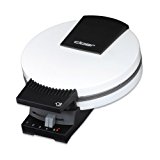
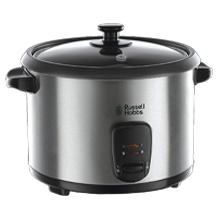
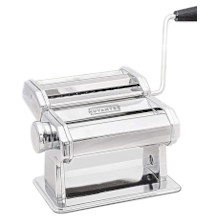
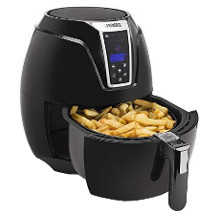
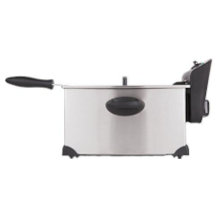

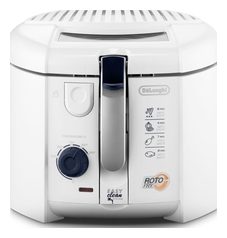
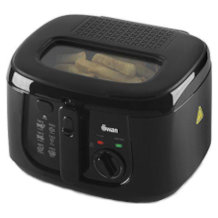
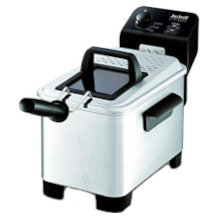
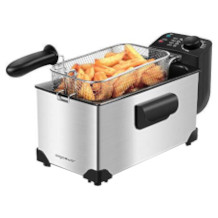
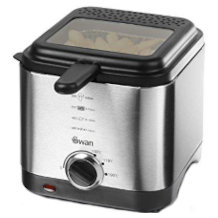
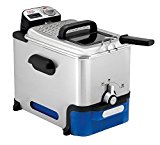
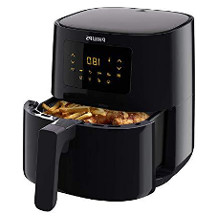

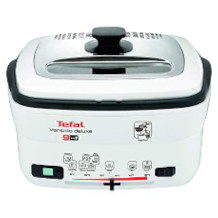

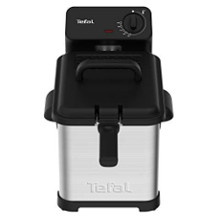
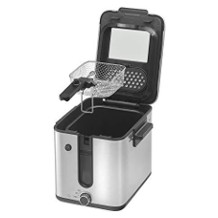
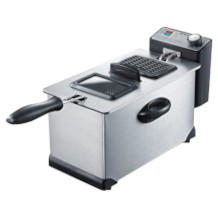
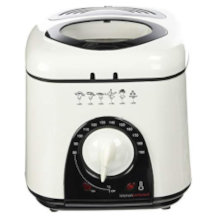
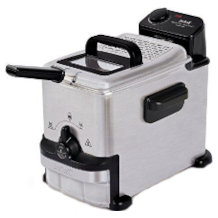
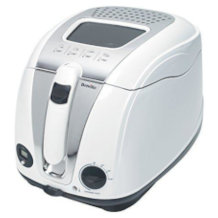

 5,215 reviews
5,215 reviews

